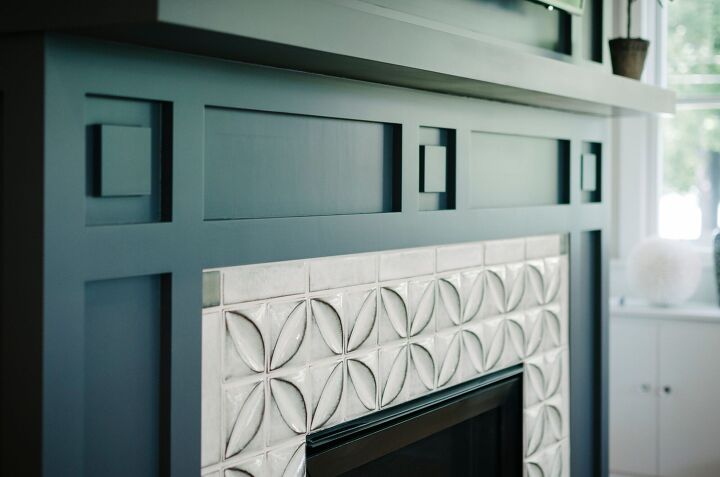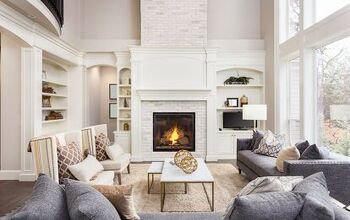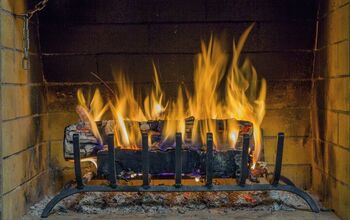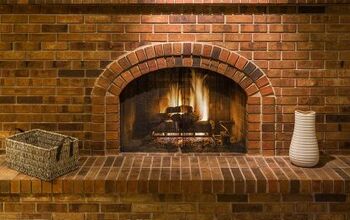Do You Need Special Paint For A Fireplace Surround?

If you have a fireplace, you are probably always looking for different ways to highlight or utilize the area. Sometimes, you might decorate it for the holidays, and you might even hang stockings from it.
Others might just enjoy watching it outline a warm vibrant fire. Over time, however, fireplace surrounds can lose their luster, and need a face lift. So, as you start shopping for the perfect paint to use on your fireplace surround, you might wonder if you need to select a special type of paint.
When you select paint for your fireplace surround, you should use a paint that can withstand a minimum of 200 degrees Fahrenheit. If your fireplace burns very hot and you use it regularly, you should buy heat-resistant paint that can withstand even higher temperatures.
Consider using a latex paint that is not only heat-resistant, but durable and easy to wash.
Before you select any random paint for your fireplace surround, you will want to read this article. We will discuss different factors that can affect your paint selection.
Not every fireplace is the same. There are different fuels that burn at different temperatures. Fireplace hearths are also varied. Some are made of wood, while others are made of brick and other materials.
Things To Consider Before Painting Your Fireplace Surround
If you are wondering whether or not you need a special type of paint for your fireplace surround, there isn’t exactly an easy yes or no answer. Fires burn at different temperatures, for one.
In fact, there are all sorts of variables you need to think about before you buy paint for your hearth/surround. Here are some of the biggest factors to take into consideration.
The Material Your Surround Is Made Of
Some surrounds are made of wood, others are made of brick. Wooden surrounds should be given special consideration, as they are flammable. So, it is all that more important to make sure there is heat-resistance.
Brick requires paint and primer that words well on porous surfaces. So, make sure you take into account the surface of your surround and what works best for it.
If It is Already Painted Or Not
If your surround is already painted, you have a better idea as to how well paint works on your surround. It also means you need to take the proper steps to sand, re-prime and paint the surface.
If you are painting over bare wood or brick, you should take extra precaution. It is best not to use any old paint, since you aren’t sure how it will react to heat. If you are unsure, it is always better to use a durable and heat-resistant paint.
The Distance Between The Surround And Flames
The design of your surround and its proximity to flames is arguably the most important factor to consider. Some surrounds are designed in such a way that they tower above the fireplace and are not remotely close to the heat source.
These fireplace sizes and their borders are far less likely to experience extreme heat, and are better candidates for using any paint that can withstand upwards of 200 degrees.
If, on the other hand, you have a fireplace surround that borders the fireplace rather closely, you might need to reconsider. If the surround is close to the heat source, then it is certainly going to be warmer than if it isn’t.
For these types of fireplaces, you should make sure you are more careful when selecting paint.
The Type Of Fuel Your Fireplace Uses
The type of fuel your fireplace burns can also play a role in the type of paint you should select. For one, there is the heat to consider. Some natural gas fireplaces are great heat sources, while others offer lots in the way of flames, but are not very hot.
Wood-burning fireplaces, on the other hand, always burn hot. Since you need to feed these fires, they are also more exposed to the hearth. Wood-burning fireplace surrounds tend to get dirtier and hotter. This means you need a durable and heat-resistant paint.
Is Your Fireplace Decorative Or Functional
If you have a fireplace that is purely decorative, you can use any paint you want. Decorative fireplaces don’t deal with the heat extremes that functional fireplaces do. On the other hand, if you have a functional fireplace that you use all the time as a heat source, you need to be very careful when you select your paint.
Is Heat-Resistant Paint Mandatory For A Fireplace Surround?
As you prepare to paint your fireplace surround, the number one question on your mind is most likely if you need to use a specialty heat-resistant paint. After all, you might have a color or paint in mind that isn’t necessarily rated to withstand very hot temperatures.
Most paints should be able to withstand about 200 degrees, but not all. So, before you go any further, make sure the paint you have in mind is rated to at least 200 degrees. Next, you need to think about your specific fireplace, since each one is designed differently. If you have a decorative fireplace that uses low-heat gas, or only an occasional log, you can usually use regular paint.
But if your fireplace gets hot, and you use it frequently, you might want to consider a heat-resistant paint. Most heat-resistant paint can withstand temperatures upwards of at least 400 degrees Fahrenheit. Choosing a heat-resistant paint lets you rest assured knowing your paint will withstand the heat and the test of time.
The Best Paint To Use For A Fireplace Surround
There are many paints you can use to paint your fireplace surround. In most cases, as long as the paint can withstand at least 200 degrees (the majority of indoor paints can) then you should be OK. But, as with any paint selection, some paints are better than others when painting your fireplace surround.
The best paint to use for a fireplace surround is a heat-resistant latex paint. Most paints are rated to withstand upwards of 200 degrees. To be safe, use a paint that can withstand even higher temperatures. You can select a semi-glass, flat or even full gloss paint.
The key is to select a paint that is durable and washable. Fireplace surrounds get dirty and need cleaning. This is particularly true for wood burning fireplaces. You need to remember to not only consider the heat, but also the mess that you will have to regularly clean.
Use an oil-based paint and heat-resistant primer. Oil-based primers are great for porous surfaces like brick. They also help create a firm wall, keeping natural elements of wood from seeping out.
Step-By-Step Guide To Painting Your Fireplace Surround
Step One: Prepare The Area
First you need to prepare your surround and the surrounding area. Remove any decorations from the shelves and then lay out a drop cloth on the ground.
Step Two: Scrub Down The Surround
You want to make sure your surround’s surface is clean and free of dirt. Fireplaces and the areas around them have a tendency to get quite filthy. You can use a degreaser or other cleaning solutions for tougher stained areas. For an organic approach, you can use half water and half white vinegar.
Either way, use a scrubber or sponge to thoroughly clean the area. Then wipe it down and allow it to dry before moving onto the next step.
Step Three: Apply Painter’s Tape To Bordering Areas
While some say it isn’t necessary, you really should use painter’s tape along the surround’s borders. This will help you create perfect sharp lines, leaving you with very professional results. This tape also helps prevent paint from going where it doesn’t belong. It makes cleanup significantly easier as well.
Step Four: Sand The Surround
If you have a wooden or painted brick surround, you should sand it. This is an important step, as it will greatly improve the success of your primer. Primer needs to grip onto its surface.
Painting primer over paint is not ideal, as it doesn’t allow the primer to really grip into anything. Create these light scuffs for the primer using sand paper.
Step Five: Wipe Down Area
After sanding, you need to wipe the area again. Use a paint brush or microfiber cloth. Then wipe down with wet paper towels and allow the area time to dry.
Step Six: Apply Oil-Based Primer
Oil-based primer is highly effective at gripping onto surfaces. It also is great at sealing the surface as well. This makes it an ideal candidate for covering wood and the porous nature of brick and even natural stone.
For best results, apply a thin layer of primer. Then allow it ample time to dry before applying a second thin coat of primer. This allows for smooth and complete coverage.
Step Seven: Apply Heat-Resistant Paint
In some cases, heat-resistant paint only needs to be able to withstand upwards of 200 degrees. This is most paint. In other cases, you might need a specialty paint. Either way, apply one very thin coat of paint. Allow it ample time to dry.
Apply a second coat. Using a combination of paint brush and a roller gives you great coverage and also a smooth finish.
Step Eight: Remove Tape, Inspect And Enjoy
It is best to remove the painter’s tape when the final coat is still drying. This helps prevent any chipping. Before removing the tape and cleaning up, make sure you haven’t missed any spots that require touch-ups.
Final Words On What Paint Works For A Fireplace Surround
There are all sorts of ways you can change the look of your fireplace. One way to really make it pop or come back to life is by painting (or repainting) it. In many cases, you can use a wide variety of paints, as many paints are made to resist heat upwards of 200 degrees.
The type of paint you need will vary based on the design and type of fireplace you have, and whether it is functional and hot, or more decorative and cool. Either way, make sure you choose a paint that can withstand the heat it must endure. Don’t forget to also choose a paint that is durable and easy to clean, since fireplaces and the areas around them get dirty.
Related Guides:

Tom Gaffey is an expert writer who currently resides in Washington D.C. Tom has a passion for real estate and home improvement writing, as well as travel and lifestyle writing. He lived the last twelve years in Hawaii where he worked closely with luxury resorts and event planners, mastering his knowledge of aesthetics and luxury products. This is where he found his passion for home improvement and a keen interest in DIY projects. Currently, Tom resides in Washington D.C, and also working on his debut fiction novel.
More by Tom Gaffey














![10 Best Cordless Leaf Blowers – [2022 Reviews & Ultimate Guide]](https://cdn-fastly.upgradedhome.com/media/2023/07/31/9070789/10-best-cordless-leaf-blowers-2022-reviews-ultimate-guide.jpg?size=350x220)







![10 Most Dangerous Neighborhoods in Baltimore [Updated]](https://cdn-fastly.upgradedhome.com/media/2023/07/31/9075655/10-most-dangerous-neighborhoods-in-baltimore-updated.jpg?size=350x220)




